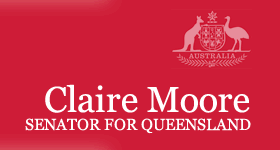Close the Gap
Senator MOORE (Queensland) (4.15 pm)-The debate this afternoon is a positive one that I think we can share. Oxfam and the National Aboriginal Community Controlled Health Organisation, which is a daunting title, released their discussion paper-which Senator Siewert sought to table this afternoon-in April 2007, earlier this year. We can look at the front page together and see a benchmark from which we can move forward. There is a stunningly beautiful photograph. Oxfam are renowned for their ability to get the message across in photographs, which I think sometimes tell peoples' stories much better than we can effectively debate them in this place. Apart from the stunningly beautiful photograph of Mornington Island in Queensland, there is a statement from Professor Mick Dodson, which I will quote. I am sure that people will continue to do this. It is a quote that I live with because I think it is one that we can hold onto as we continue this debate. Mick Dodson stated:
The statistics of infant and perinatal mortality are our babies and children who die in our arms. The statistics of shortened life expectancy are our mothers and fathers, uncles, aunties and Elders who live diminished lives and die before their gifts of knowledge and experience are passed on. We die silently under these statistics.
That quote is important for us to hear, but it is not negative; it is actually a statement that gives us the challenge which we are expected to take forward. The Close the Gap campaign-which has been so effective across our country in engaging people in the community in effectively considering the issues facing Aboriginal and Islander people in our community-looks at our history. As Senator Humphries said, you cannot just make a simplistic statement about what should happen; what we should do is understand the complexities of what has happened. It is an important year to do that. Firstly, we now have the opportunity to consider the impact of 40 years since the referendum gave Indigenous people the right to vote in this country. Secondly, we can look at the movement forward, taking a snapshot of what has happened before and together facing the negatives that we have heard but not being overwhelmed by those negatives, because if we do that we will not move forward. The statistics are there and, as Professor Dodson said, the statistics about the life expectancy of people, the unacceptable infant mortality rate and the way of life of so many people in our community roll off the tongue. We can have an inordinate number of debates, as we have done, and the Productivity Commission has a huge volume of statistics, most of which are negative, but what we can do is learn from them. We have the ability to learn from those statistics. One of the really effective things about the Close the Gap campaign is the research of processes that have worked, and we can learn from those. It is not just about extra funding, although there must be greater funding. Senator Humphries pointed out the growth in funding over the last couple of years, but it is not enough by itself. When we have Mick Dodson's words in mind, we hear what those statistics mean to Indigenous people: they are about their families, the people who mean most to them. You cannot just quote statistics; you have to concentrate on what can be done to address the problems. The problems are known. We have had these debates in this place before and we know the issues that Senator Siewert outlined. So many reports have been tabled in this place and as far away as the United Nations, talking about issues of disadvantage in indigenous populations, not just in Australia. That came out in the recent debates about the international declaration on indigenous peoples. The issues that are confronting indigenous peoples are not peculiar to our country. What we have to address is that the issues for Indigenous people in our country have been bad. This generation has an opportunity to put in place steps forward, as the Close the Gap campaign is asking us to do, within a generation-a time frame of 25 years. I think that most of us would be thinking positively about being around for 25 years. At the end of that time, we will be able to take another snapshot and be able to objectively assess whether the things that have been put in place in 2007 effectively, objectively and cooperatively made advances. At the end of those 25 years, which is part of the process around the Oxfam Close the Gap campaign, we will be able to see what advances have been made around the issues of mortality rates, longevity, education and housing-all those things that we know about. It is our hope and our challenge that in 25 years time we will be able to say these plans have worked.
Maybe we will not have solved all the problems. In fact, there has never been any act which has solved all the problems. But the people who are sitting in this place in 25 years should be able to say that, in 2007, measures that were cooperatively agreed-as the Oxfam report says, amongst all levels of government and engaging all the people who are citizens of this country-have made a genuine difference. That is the challenge: to make a difference. Rather than concentrating on the past and what has not worked, we should acknowledge the past and not pretend that it did not happen. Way too often people become too defensive and try and come up with excuses about what happened-how much money was spent and where it could have been misspent. They concentrate on those things instead of doing what Oxfam has asked us to do: look at the workforce; improve access to education and culturally appropriate primary health care; acknowledge what is happening now and the knowledge that we have.
The Productivity Commission report of two years ago left us in no doubt about the state of our nation now. There is no grey in this area. We have the statistics. They have been gathered and will need to continue to be gathered. When we are looking at those statistics, when we are groping to come up with ways to ensure that life expectancy is improved and we are looking at ensuring that maternal and child health statistics are improved, I think it does us good to continue, as Professor Dodson said, to see the people who are behind those statistics. Somehow it makes it a stronger argument when you are looking at those issues and statistics as being people and family members. One of the encouraging things about the whole discussion around the Close the gap report has been the way that there has been community engagement. I think that things like the photographic exhibition which Senator Humphries referred to in his contribution have a really valuable role to play in ensuring that we see what does work. Many have been able to look at that photographic exhibition and see those glorious, positive photographs of people who are part of our community now. We need to go back in 25 years time and have photographs taken of those same families to ensure that they are still here-and to map the progress of that wonderful little boy who is on the front cover of the Closing the gap report to see where he is in 25 years. That is the challenge. There is an understanding about the work that we are doing and the focused funding-the funding that is not linked to punishment. My concern about what is happening at the moment in the Northern Territory is that any value achieved by the influx of medical help and the influx of people involved in the process is linked to a sense of punishment. That is not the expectation of Close the gap-it is not about people coming in from outside to work on the community. We are well beyond that. The expectation of Close the gap is that we will work with the community to achieve outcomes. When that can be achieved then people can gather together and say that we are part of a wider Australia. All the advantages that any one of us has should be available to everyone-in particular, in this campaign, to Aboriginal and Islander people-no matter where they live. One of things that I think has been the most damning over the last couple of months is that there seems to have been a focus almost exclusively on the Northern Territory. Close the gap is not a campaign for people who live in the Northern Territory; Close the gap is a campaign for Aboriginal and Islander people across the whole country no matter where they live. And that is the challenge for us. In terms of positives, I look to the work that is being achieved by the mums and babies program in Townsville. That is exactly the kind of program that does work. It has been celebrated in Close the gap. I think that if we can work together in that way then in 25 years we will be able to show success and not continued concern about the challenges that we have not met.




